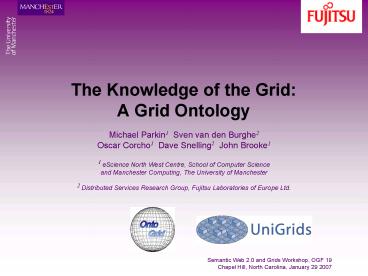The Knowledge of the Grid: A Grid Ontology - PowerPoint PPT Presentation
1 / 12
Title:
The Knowledge of the Grid: A Grid Ontology
Description:
This work defines concepts at a higher level so that we can map to and between other work ... Barcelona Supercomputing Centre plan to use the ontologies ... – PowerPoint PPT presentation
Number of Views:43
Avg rating:3.0/5.0
Title: The Knowledge of the Grid: A Grid Ontology
1
The Knowledge of the GridA Grid Ontology
- Michael Parkin1 Sven van den Burghe2
- Oscar Corcho1 Dave Snelling2 John Brooke1
- 1 eScience North West Centre, School of Computer
Science - and Manchester Computing, The University of
Manchester - 2 Distributed Services Research Group, Fujitsu
Laboratories of Europe Ltd.
2
Overview
- Interoperability in Grids
- Background, motivation and approach this problem
- Extensible knowledge framework
- Foundational ontology and OGSA, S-OGSA ontologies
- Example concept from Unicore Ontology
- Current status and conclusions
3
Grid Interoperability
- There are two parties needed to make any Grid
- Consumers (inc. applications) that want to use
resources (inc. data) - Providers willing to share/sell resources
- These have different perspectives on the
resources required/offered - Need to determine if two Grids are functionally
equivalent - Not just that they run the same middleware
- Needed when brokering across multiple Grids
- Requirement to describe hybrid Grids
- Two dissimilar Grids join how do we describe the
hybrid? - Mediation (interoperability) is required between
these views
4
Motivation for an Ontology of the Grid
- Existing glossaries and vocabularies not suitable
for this task. e.g. - The GLUE schema models the abstract structure of
the resources this is what we are, this is
what we can do - Unicore AJOs represent resources requests I
want this work done in time for this event - All lack formality in their definitions, dont
express a shared point of view, are not explicit,
dont cover all the concepts and components that
a Grid may have - This work defines concepts at a higher level so
that we can map to and between other work - An ontology allows us to express a formal,
explicit specification of a shared
conceptualization
5
Knowledge of the Grid
- Building an ontology of Grid concepts allows us
to Noy 2001 - To share common understanding of the structure of
information among people or software agents - To enable reuse of domain knowledge
- To make domain assumptions explicit
- To separate domain knowledge from the operational
knowledge - To analyze domain knowledge
- Expose service metadata
- This is different to knowledge on the Grid
(Goble, deRoure, Shadbolt, Fernandes, Ch. 23 of
The Grid 2, 2004)
6
Methodology
- A simple methodology developed as part of EU GRIP
Project - The Grid idea is too general
- Means many things to many people
- We abstract what is meant by the Grid
- This has been done by observation, not theory
- Looked at what people have successfully developed
and deployed - Developed an ontology from these observations,
extracting key concepts
7
Knowledge Architecture
- Layered, modular model for maintainability,
extensibility, and reusability. - First tier common, base Grid concepts
- Second tier domain-independent,
middleware-specific concepts - Third tier domain ontologies describing Grid
instances
8
Knowledge Architecture
- Layered, modular model for maintainability,
extensibility, and reusability. - First tier common, base Grid concepts
- Second tier domain-independent,
middleware-specific concepts - Third tier domain ontologies describing Grid
instances
9
Foundational Ontology
- Defines the high-level, common, general-purpose
Grid concepts that can be re-used in the
description of - Grid middleware, infrastructure, application,
protocols, services, resources and Virtual
Organizations. - Contains 100 concepts and 150 relationships
(properties) - Definitions and relationships taken from many
sources, including dictionaries, glossaries, OGF
docs, IETF RFCs... - Many concepts are from OGSA e.g. Task (a
definable unit of work) as they are universal
across all Grids - Can be broken into several categories
- Processes, Protocols, Infrastructure, User and
Security, Actions and Tasks, Activities...
10
OGSA S-OGSA Ontologies
- Separated out ontologies containing OGSA and
S-OGSA concepts - OGSA service-orientation applied to Grid
computing - S-OGSA semantic bindings and knowledge entities
for OGSA - Describes how to expose the metadata of a
resource - Concepts in S-OGSA Ontology include
- SemanticBinding, KnowledgeEntity
11
Unicore OntologyExample Concept
- Unicore Gateway
- Assert that it is an Access Point that
authenticates X.509 certificates and supports the
UPL - Anything performing authentication of an identity
credential is an Authentication Point - Any class supporting a protocol is a Service
- Reasoner can determine that a Unicore Gateway is
a Service Authentication Point
12
Current Status
- The Grid Resource Ontology is available from
http//www.unigrids.org/ - Written in OWL, fully commented and proven as
consistent - Reasoners to enable us to deduce properties not
explicitly entered - e.g. UNICORE Gateway is an Authentication Point
- Check for completeness of functionality, and to
compare functionality across Grids that use
different descriptive terms - Already being used by OntoGrid
- Barcelona Supercomputing Centre plan to use the
ontologies - Please let us know your comments!

